Planning a cruise or road trip along the Danube River and wondering what to do and see?
The Danube River is a venerable piece of geography. Napoleon dubbed it “the king of the rivers of Europe.” It’s the second longest river in Europe, running through 10 countries.
The blue-green river alley is dotted with gorgeous landscapes — mountains, gorges, rolling vineyards.
It’s ornamented with ruined castles, beautiful abbeys, and tiny time warp towns. Whether you’re cruising, driving, or cycling, you’ll be enchanted.
In this guide, I’ll take you on a journey along the Danube, and give you a look at its top attractions and must visit towns.
There are many different routes to take when visiting the Danube River attractions. And you could spend 1 week or 1 month there, depending on your vacation allotment and how fast you like to travel.
I spent 3 weeks touring the sites, with some extra time in Munich and the blockbuster destinations on Germany’s Romantic Road.
I took a fairly classic route beginning in Budapest Hungary and ending in Nuremberg Germany.
Here’s a snapshot glance of what you can see on the Danube:
- Budapest
- Esztergom
- Bratislava
- Schloss Hof
- Mondsee
- Salzburg
- Vienna
- Schönbrunn Palace
- Klosterneuberg Abbey
- Krems
- Dürnstein
- St. Michael Kirche
- Melk Abbey
- Linz
- Bad Ischl
- Passau
- Vilfshofen
- Regensburg
- Ulm Minster
- Nuremberg
- Weissenkirchen
Top Attractions On the Danube River
1. Budapest Hungary: A Bathing Beauty
Beautiful Budapest is the perfect way to start your tour of the Danube River. Budapest has a romantic and exotic reputation. It’s a a hot European city break and dubbed the “Paris of the East.”
Budapest is picturesquely divided in two by the river, with Buda on the west and Pest on the east. It has a sense of expansive grandeur.
Both sides of the city have different personalities and offer different cultural experiences. You can see their highlights on a magical walking tour of Budapest.
Buda is charming, classy, and quiet. It’s filled with museums, castles, and elegant homes on cobbled streets.
Pest is wilder and cosmopolitan, and where most of the tourist sites and ruin bars are located. Both are beautiful at night, illuminated by lights and cradled by the Danube.
You’ll be dazzled by St. Stephen’s Cathedral, the Great Synagogue, the stunning Parliament Building, and the Dracula-like Vajdahunyad Castle.
Don’t forget to indulge in the Budapest specialties: ruin bars and thermal baths. Széchenyi Thermal Bath is the most elaborate and popular. Click here to book a guided pub crawl of Budapest’s ruins bars.
But I preferred the less touristy Gellért Thermal Bath, at the foot of Gellért Hill. If you have the time and inclination, hike up the hill before your steam and soak for one of the best views Budapest.
2. Esztergom Hungary: UNESCO Basilica
Esztergom is a quaint village, to be sure. But the main reason to visit is its massive UNESCO-listed Esztergom Basilica. Consecrated in 1856, the basilica is the largest church and tallest building in Hungary. Its dome stands 235 feet tall.
Esztergom Basilica is the seat of the Catholic Church in Hungary. Its gigantic bell can be heard ringing for miles around.
You can hoof it to the top of the dome for views over the Danube valley. The basilica itself is free, but you’ll need a ticket to visit the treasury, dome, and crypt.
The interior’s not as stunning as the exterior. But, consistent with its ethos, you’ll find the largest painting in the world on the altarpiece—the Italian painter Grigoletti’s version of the Assumption of Virgin Mary. It measures 44 feet by 22 feet.
3. Bratislava Slovakia: Quaint Old Town
Bratislava is the tiny capital of Slovakia. It’s a little over an hour from Vienna and a popular Danube River cruise excursion.
Bratislava’s vintage-y old town is filled with pastel colored houses, cobbled streets, quirky bronze sculptures, and the world’s most adorable pastry shop, Konditorei Kormut.
Be sure to buy some honey at Medovy Obchod in the old town, where you can sample the honey yourself. We purchased some delicious vanilla and wildflower honey, along with some beehive candles and Bryndza cheese.
Bratislava also boasts a unique, almost over the top, blue church, the Church of St. Elisabeth, a 10 minute walk from the old town.
Everything about the Art Nouveau church is blue — the interior (with added punches of yellow), the exterior, and even the tiles on the roof.
Even better, Bratislava is crowned with a historic castle, which is really the iconic spot in the town.
Perched on a small hill and about a 15 minute hike, the castle is the best viewpoint of the old town. Outside, it’s an elegant vision, with Gothic and Renaissance elements. Inside, there’s a museum of history.
Click here to book a full day guided day trip tour from Vienna to Bratislava. Or, book your own 2 hour guided walking tour for when you arrive.
4. Schloss Hof, the Hapsburgs’ Rural Digs
Schloss Hof is Austria’s largest rural palace complex. It’s only an hour from Vienna in the Marchfield region of lower Austria and 30 minutes from Bratislava.
Schloss Hof was the country seat and summer escape pad of Empress Maria Theresa. She bought it for her husband Francis and to “relieve the soul of the burden of ruling.”
When the notoriously thrifty Francis died, Maria Theresa expanded the palace and added a story to the schloss in a classic French style. One needs room for the servants, after all.
The subsequent Hapbsburg generations didn’t appreciate her bucolic idyll and let Schloss Hof decline.
The palace was eventually restored and re-opened to the public in 2005.
The prettiest rooms are the French inspired ballroom, the Sala Terrena, the chapel, and the dining room with gorgeous reconstructed wall covers. We had an excellent guide, dressed in period costume no less.
The seven tiered Baroque garden is also very lovely. It was created by Lucas von Hildebrandt and Anton Zinner, who were also the designers of the Belvedere Palace gardens in Vienna.
The gardens spread out like a geometric carpet. There’s a gorgeous fountain and the grounds are dotted with whimsical sculptures.
Here’s my complete guide to Hof Palace.
5. Mondsee Austria: Charm on the Moon Lake
Mondsee is a delightful alpine Austrian village just 20 minutes from Salzburg. It makes a great day trip if you’re based there.
The charming town lies on a crescent shaped lake called the Moon Lake. Take your time to explore all the colorful nooks and crannies of the historic center. Then, promenade around the tranquil lake.
The star attraction of Mondsee is its 15th century church, the Basilica of St. Michael.
The church is famed for starring as the wedding venue of Maria and Captain von Trapp in the musical Sound of Music. Not surprisingly, it’s a popular spot to marry today.
The basilica sits in a spacious square, its twin golden towers and four story facade dominating the small village.
The towers are linked by an interesting concave middle section. Inside, the bright three-aisled church is pretty in pink, with especially nice frescos in the Peter chapel.
The 17th century interior features Baroque-style altars, created by Matthais Wichlhammer and the famous Swiss Baroque sculptor Meinrad Guggenbichler.
The black and gold stands in sharp contrast to the cream and pink setting. I preferred the pink, for the most part.
6. Salzburg: Fairytales Are Real
Who doesn’t love Salzburg? Well, possibly those who are allergic to tourists.
But Salzburg is a dream worth dreaming, set on the fast flowing Salzach River. It’s one of the best attractions on the Danube.
You may want to book a guided walking tour with a historian to get oriented.
Salzburg is studded with elegant domes and spires and crowned with a doughty clifftop fortress. The city is synonymous with both Mozart and the Sound of Music. Personally, I’m only a fan of the former; Mozart is life.
Take in the regal Reisdenz and the Salzburg Cathedral in the Domplatz. Make the steep (but short) hike up to the well-preserved 900 year fortress. (Click here to book an entrance ticket.)
Then, visit Salzburg’s #1 attraction, Mirabell Palace and its lovely gardens. The interior is exceedingly lavish. The highlight is the Marble Hall, flashy with marble, stucco marble, and gilded stucco.
You may even want to book a classic Sound of Music guided tour. You can also attend a concert at Mirabell Palace.
You indulge in an Austrian food tasting tour. You can walk in the footsteps of Mozart on a guide tour. Or take an architecture tour to take in all of Salzburg’s stunning buildings.
7. Vienna: The Streets Are Paved With Culture
Vienna is like an open-air museum with its stunning imperial palaces and grand Baroque architecture.
It’s also the birthplace of classical music and rich in Habsburg dynasty history. The city center is pedestrian-friendly and boasts green parks and cozy cafes.
But Vienna isn’t just about its past glory. It has evolved into a hip destination with new museums, stylish boutique hotels, trendy restaurants, and vibrant neighborhoods. Vienna has a cool and contemporary side that may surprise you.
You may want to kick off your first day in Vienna with a classic city walking tour. You can also book a private walking tour that includes some hidden gems.
You should pre-book skip the line tickets and tours to must visit attractions in Vienna — St. Stephen’s Cathedral, Hofburg Palace, the Opera House, and the Belvedere Palace.
Be sure to stroll down Graben street and indulge in Vienna’s specialty: the Sacher Torte, a delicious concoction of chocolate, cream, and apricot jam.
Vienna is also overflowing with world class museums. So try to head to Museumsquartier for a cluster of them in a hip square teeming with cafes.
For more information, check out my 3 days in Vienna itinerary.
8. Schönbrunn Palace
Schönbrunn Palace, outside Vienna, is a UNESCO-listed site and the height of elegance. Don’t dally.
The lines worsen as the day goes by. Purchase your tickets online in advance. You can also hop on a guided skip the line tour, book a guided tour with a historian, or a dinner and concert evening.
The swishy Renaissance palace was the summer home of the Hapsburg dynasty, the family that ruled the Austro-Hungarian empire for nearly 650 years.
You’ll want to check out the palace itself and the extensive garden complex. Be prepared to walk.
Of Schönbrunn’s 1441 rooms, 40 are open to the public via audio guide or guided tour. The “Imperial Tour” takes you into 22 rooms, including the imperial apartments of Emperor Franz Joseph and famous wife, Empress Sisi.
The “Grand Tour” continues to 18 more rooms and includes the 18th century interiors from the time of Maria Theresa, who conceived of and built Schoenbrunn.
Don’t miss the Mirror Room, where Mozart gave his first concert at age 6. And the Schönbrunn experience isn’t just limited to the palace. Oh no.
There’s the Apple Strudel Show, the Marionette Show, the Gloriette monument, the Orangery, the Imperial Carriage Museum, and a zoo. You could spend your whole day here, if you were so inclined.
9. Klosterneuburg Abbey
Klosterneuberg Abbey is another doughty edifice overlooking the Danube River. It was consecrated in 1136 by Babenberg aristocrat Margrave Leopold III. He chose the site on a superstitious whim.
Legend holds that, on his wedding day, his wife’s veil was stolen by a gust of wind. Nine years later, he found the veil in a tree branch, saw a vision of the Virgin Mary, and decided on the spot to build a monastery.
The medieval building, like so many others, was given a Baroque rehab in the 18th century. Simultaneously, Emperor Karl VI decided to construct a grandiose palace alongside it.
The palace was patterned after the Escorial Palace in Madrid — a former Hapsburg territory he had just ceded. Its construction was abandoned, however, when money ran out.
The palace is rather gaudy and drips with gold. It suggests wealth rather than elegance. The monks must have sighed in relief when it was left in its truncated, although still quite colossal, state.
The abbey is a more restrained affair. But the church still boasts beautiful frescos, depicting the expulsion of the Turks.
Its magnificent altar was created by Nicholas Verdun.
It’s decorated with 50 Byzantine-inspired gilded copper plates illustrated with biblical scenes. I liked the panel with 12 cows best.
10. Krems: Into the Wachau Valley
Now you’re heading into one of the prettiest stretches of the Danube River, the Wachau Valley. I was dazzled by the tranquil blue-green beauty of the Austrian countryside.
You may want to book a full day bike tour in the valley. Or book a full day tour of Wachau that includes skip the line entry at Melk Abbey and a wine tasting.
In Wachau, the glossy landscape features vineyards, forested slopes, wine-producing villages, and imposing fortresses at nearly every bend.
Your first point of call is Krems, the gateway to the 24 mile Wachau Valley. In the middle ages, Krems was a major center of trade and wine production.
The best thing to do is explore the meticulously restored medieval town.
Start by admiring Stein Tor, the 15th century gate and symbol of Krems. Then stroll down cobbled Landstrasse, the pedestrianized center. If you want to do some shopping, Krems is an ideal place to indulge.
Check out the Bürgerspitalskirche Church and Renaissance style Town Hall. Just 5 minutes from Krems is its cute neighbor, Stein an der Donau.
You can also explore Gottweig Abbey from Krems. Gottweig is a Benedictine abbey nicknamed Austria’s Monte Cassino (rocky hill) because of its epic location.
11. Durnstein: Austria’s Prettiest Village
Durnstein may be Austria’s prettiest village. It’s just so darling, and charmingly sleepy.
Despite its diminutive size, Durnstein’s tourist-fly popular. Set against the forested hills, its beautiful blue abbey belltower is one of the Danube’s most striking sights.
Start your visit by hiking up to the ruins of a fairytale castle, the Kuenringerburg, set on a rocky slope.
The craggy castle was erected in the 12th century. It was destroyed during the 30 Years War, but later partially restored.
When you’ve descended, wander Durntein’s picturesque streets. The “new castle” was built in 1629, but is now a swishy hotel.
Pass by the 16th century town hall, the Kuenring Tavern, the Pillary, St. Clara’s Church, and the romantic-looking Gothic charnel-house.
Don’t forget Durnstein’s main attraction, its lovely wedding cake monastery. The abbey was constructed circa 1410.
But the new Baroque building was erected between 1720-33. It was modeled after nearby Melk Abbey.
The abbey church was consecrated in 1723. There are colorful side altars and a creamy stucco vaulted nave.
12. St. Michael Kirche: Ancient Fortified Church
Saint Michael Kirche, an ancient fortified church, stands alone on the Danube without a surrounding town.
But fortified churches were relatively common in the Middle Ages, when the Wachau Valley wasn’t so peaceful. The churches served as a well-defended place of refuge during the threat of Ottoman attacks.
I stopped at St. Michael Kirche for a picnic lunch on a bike ride through the Wachau Valley. It was a lovely setting.
The church is ancient, dating back to the 10th century. You can explore inside, ascend the tower, and peek into a window slit to see a pile of skulls.
13. Melk Abbey: Austria’s Baroque Blockbuster
Beaming like a halo over the tiny village of Melk stands Austria’s prettiest church: Melk Abbey. You can book a guided day tour of the abbey from Vienna.
Its elegant yellow buildings form one of the most important landmarks and religious complexes in Europe. Melk Abbey is definitely one of the top attractions along the Danube.
The abbey is a blockbuster Baroque ensemble. It’s an incredible building, both inside and out. Marble, frescos, spiraling staircases, stately royal rooms, and gilt — oh my!
Melk Abbey fulfills the promise of Baroque design to “overwhelm the viewer.” But not in an overly gaudy way that the Baroque style sometimes can. It charms with yellow, pink, and gold sweetbox tones.
Aside from its gleaming exterior, Melk’s interior highlights are the cloisters, the frescoed church, and the library. A gorgeous pink and gold spiraling staircase connects the library and the glittery church.
Melk Abbey also has some beautiful gardens with a pavilion filled with pastel frescos and a restaurant, should you need some refreshment.
14. Linz Austria: Lovely and Underrated
Austria’s third biggest city is underrated and often scoffed at as a provincial industrial town.
It doesn’t help Linz’ reputation that Hitler was born near Linz and considered it a spiritual center of the Third Reich.
But Linz is making a comeback. In 2009, it was named one of the European Capitals of Culture and maintains an educated atmosphere.
Ars Electronica is a fascinating science museum. And the Kunstmuseum Linz is a glittering modern art hotspot in a funky building.
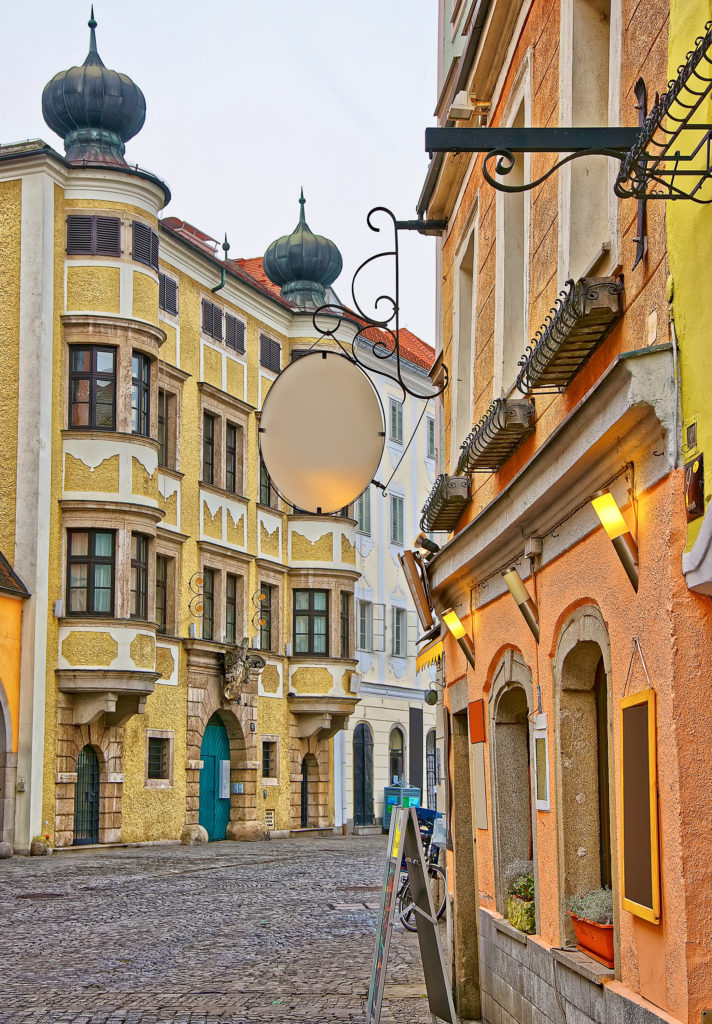
It’s true that the Linz riverfront is rather dreary, despite the new museums plunked on in. But if you walk into the old town from your cruise port, you’ll find Linz’s charm.
Sleek trams glide down the attractive main drag. There are plenty of cobbled streets, half timbered houses, and brick towers to explore.
Aside from the medieval goodies, I had one of favorite meals on my entire Danube roadtrip in Linz at Herberstein.
You’ll be fed delicious and inventive food, while swathed in exposed brick in a town house of the former Kremsmunstererhaus monastery.
15. Bad Ischl: A Spa Town Fit For Empress Sisi
Bad Ischl is an alpine spa town on the Train River in Upper Austria. If you’re en route from Vienna to Salzburg, it’s a pleasant stop.
Bad Ischl is listed among 16 towns on UNESCO’s Great Spas of Europe. So you’ll need to dip your toes into Bad Ischl’s thermal baths.
Bad Ischl is also Empress Sisi land, and forever linked to the Hapsburg dynasty.
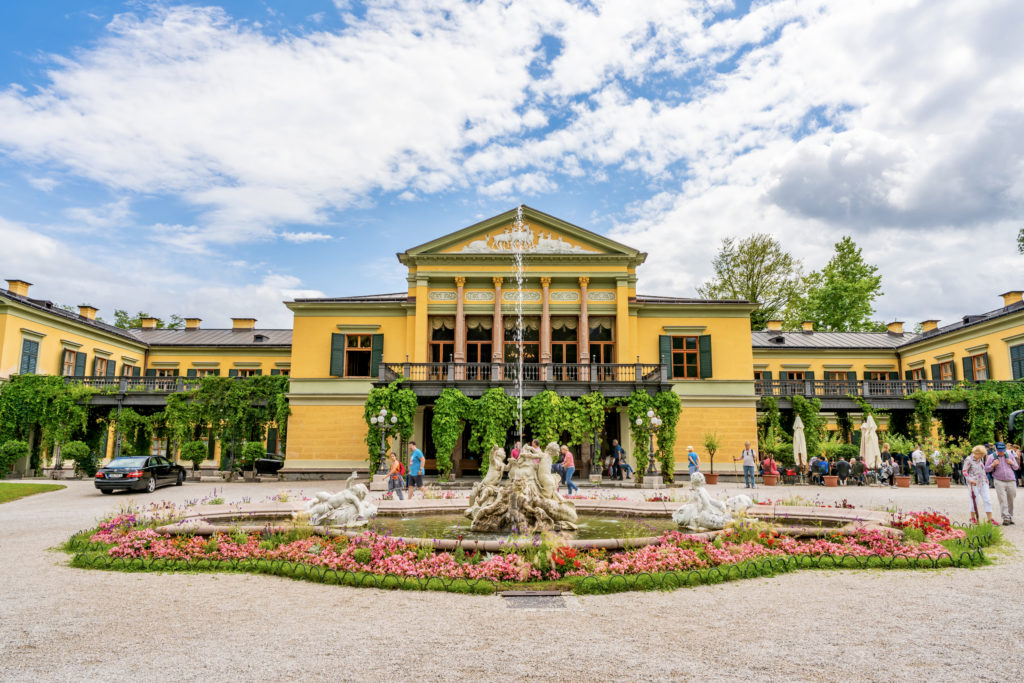
Empress Elisabeth was the “reluctant empress” — the famous lost soul and perpetually wandering wife of Emperor Franz Joseph in search of a geographical cure. She practically invented the term.
Bad Ischl’s ochre-colored Imperial Villa was their official summer residence, becoming their “heaven on earth.”
But, here, they also suffered through their loss of their first child and the mysterious death of Sisi’s cousin Mad King Ludwig. Today, Kaiservilla is a museum.
16. Passau Germany: the “Venice of Bavaria”
Passau is one of the prettiest and best preserved medieval towns in Bavaria and all of central Europe.
It’s been dubbed the “Venice of Bavaria.” Even Napoleon liked it, opining: “In all of Germany I never saw a town more beautiful.”
Lovely Passau is built on a slender tapering peninsula, surrounded by three rivers — the Danube, the Inn, and the Ilz. At times, it seems to almost float above the water.
Its architectural splendor is the legacy of its medieval rulers, the bishop princes. Rows of sweetbox pastel houses line the banks of all three rivers. Above them, is a vista of onion dome spires and curving and pointy towers.
In the heart of the city lies St. Stephen’s Cathedral, with intricate stucco decoration, and the Rathaus (town hall).
They’re surrounded by a maze of streets and cute little shops.
Across the river is the rather foreboding Veste Oberhaus. It’s a 13th century fortress of turrets, walls, and towers.
It can be reached by climbing a flight of 20 stairs. It’s worth it for the killer views of Passau and the Danube.
17. Vilshofen: Under the Radar Bavarian Charm
Cute little Vilshofen is an off the beaten path gem in Bavaria. Most cruise ships don’t even stop there.
But I adored my stroll through its old world historic quarter, and it was tourist free.
Visit the Benedictine Abbey Schweiklberg, St. John the Baptist Church, the City Tower, and the Hilgartsberg Castle ruins.
18. Regensburg: A UNESCO-Listed Medieval Marvel
Nicknamed the “northernmost Italy,” Regensburg is another authentic Bavarian town just bursting with charm.
Regensburg’s UNESCO-listed Alstadt (old town) escaped unscathed from wartime bombing. I think it’s a must visit town in Bavaria.
Regensburg is filled with pointy towers, cobblestone streets, beer gardens, and pure unadulterated charm. Towering over it all is Regensburg’s 13th century Gothic cathedral.
The best thing to do in Regensburg is just amble through the warren of lanes in the historic old town. The atmospheric streets are filled with lovely churches, hidden nooks, pastel facades, and endless cafes.
You can hang out in front of the cathedral in the Domplatz and admire its gargantuan dimensions.
Visit the swishy St. Emmeram Palace, the old town hall and its torture chamber, and the Neupfarrplatz and the Neupfarrkirche chapel.
Stroll over the iconic Stone Bridge to the Stadtamhof neighborhood, which seems like a rainbow of colorful houses.
If you want to check out the best sites in Regensburg, here’s my complete guide to Regensburg.
19. Ulm Minster: World’s Tallest Tower
Who can resist a superlative? The town of Ulm is home to Ulm Minster.
It’s the largest Protestant church in Germany and boasts the tallest church tower in the world (not counting the unfinished Sagrada Familia in beautiful Barcelona). The church attracts devotees from all over Germany.
Construction began in 1377. But the church wasn’t didn’t finish until 1890.
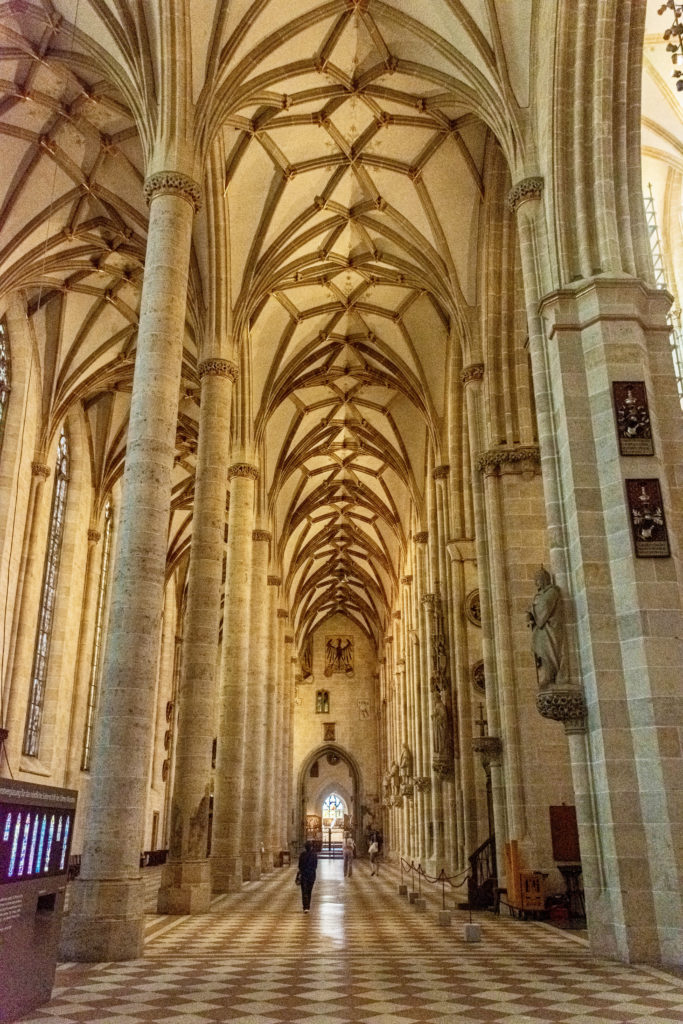
Insane dimensions aren’t conducive to quick church building. But it was worth the wait for its beautiful Gothic architecture and interior artwork.
If you’re extremely ambitious, hike up the 768 steps (gulp!) of the Ulm tower for uninterrupted views over the town. It might take you a day to recover. You’ll at least need bratwurst and beer.
A fun fact is that Einstein was born in Ulm. The house he was born in was destroyed in WWII. But there’s a street named after him and a memorial.
20. Nuremberg Germany: Bratwurst and Gingerbread
Nuremberg is one of the top attractions on the Danube and, to my mind, one of the best small cities in Europe.
It was love at first sight for Nuremberg and me.
I was based there for a week while touring northern Bavaria and Germany’s Romantic Road.
Nuremberg a magical stunner of a city, with munchable gingerbread and tasty bratwurst. Nuremberg is crowned by an ancient castle, scattered with candy cane houses, and has some must see museums.
Nuremberg isn’t just a pretty face either. It’s multi-faceted, with a tumultuous past.
As a former imperial city and medieval stronghold, it’s got layers of history, some of it a dark and brooding Nazi-infused variety. That duality is part of Nuremberg’s allure.
For the full scoop, check out my guide to the must see sites in Nuremberg. I also have a guide to the Nazi and WWII sites in Nuremberg.
You can go on a 2 hour guided walking tour of pretty Nuremberg. You also book a guided tour of the WWII sites.
21. Weissenkirchen, the White Church
Weissenkirchen is another cool attraction on the Danube. It means “white church” in German.
And that’s exactly what you’ll see. With red roofs and a stout defensive walls thrown in for good measure.
The 14th century Gothic church served as both a place of worship and as a defensive fortification against plundering Turks.
The tiny village is picturesque. Small red roofed houses crowd the cobbled town square. Narrow winding streets lead to vineyards.
If you want to learn more about Wachau’s wine heritage, stop in at the Wachaumuseum.
I hope you’ve enjoyed my guide to the must visit attractions and towns on the Danube River. You may enjoy these other Austria travel guides and resources:
- 3 Days in Vienna Itinerary
- 2 days in Salzburg itinerary
- 1 day in Salzburg itinerary and day trip guide
- Guide To the Wachau Valley
- Beethoven Guide To Vienna
- Klimt Guide To Vienna
- Guide To the Sisi Museum
- Guide To the Belvedere Palace
- Things To Do in Vienna in Winter
If you want to see the top attractions on the Danube River, pin it for later.

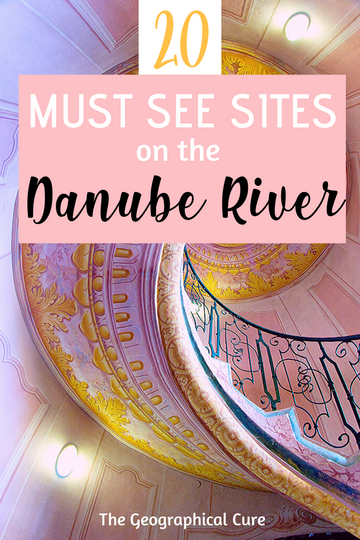
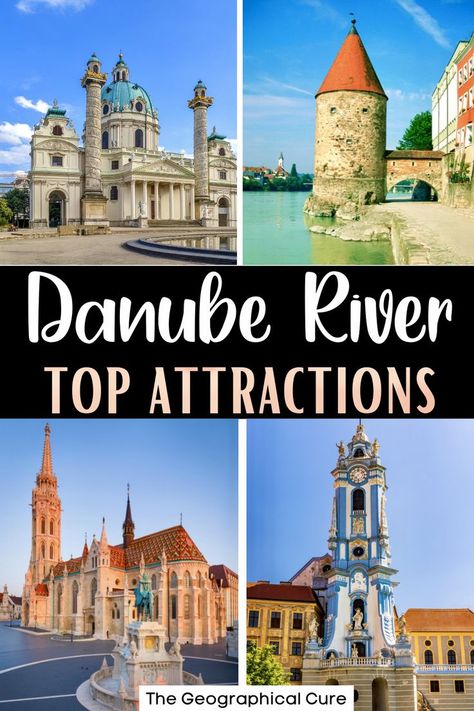
Hello Leslie,
This is a great travel site, but the photo used to illustrate Linz, Austria is actually from Linz am Rhein, Germany(by the Rhine and not the Danube).
The Danube has many great sights downstream from Budapest as well in Croatia, Serbia, Romania and Bulgaria should you have the chance to see those parts.
Thank you Peter! I have fixed that error. I really liked Linz. I loved Croatia, what a beautiful country. Hope to get to some of those other destinations you mention as well.